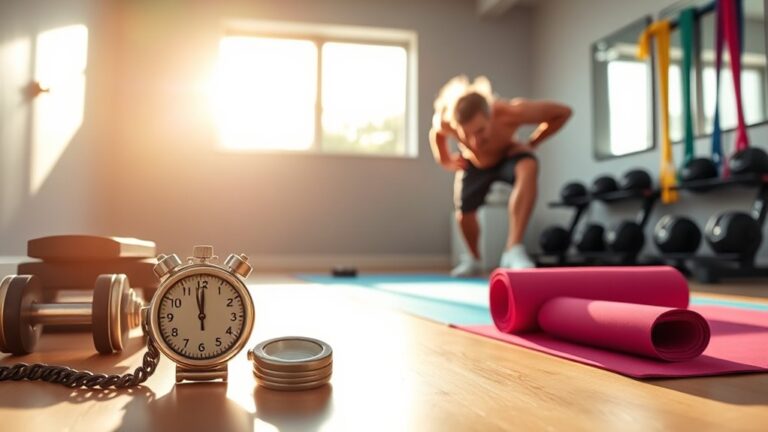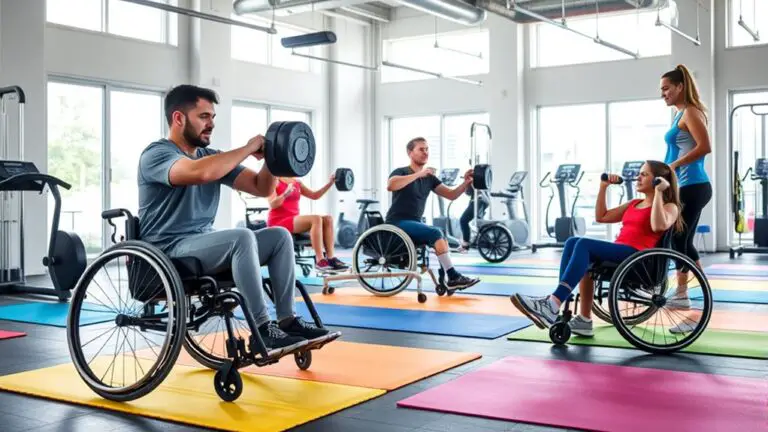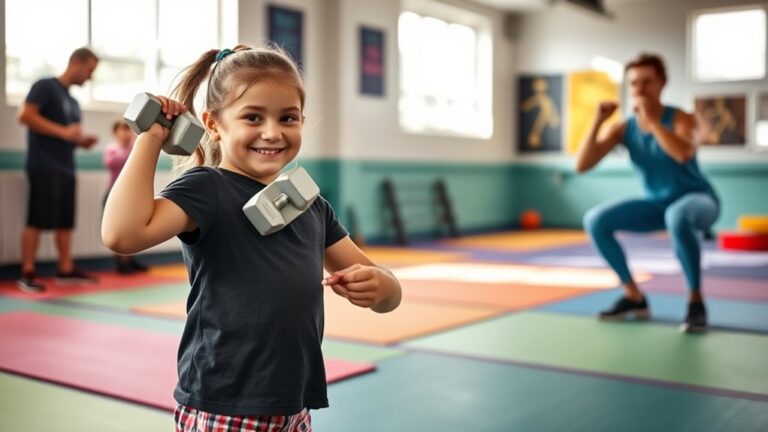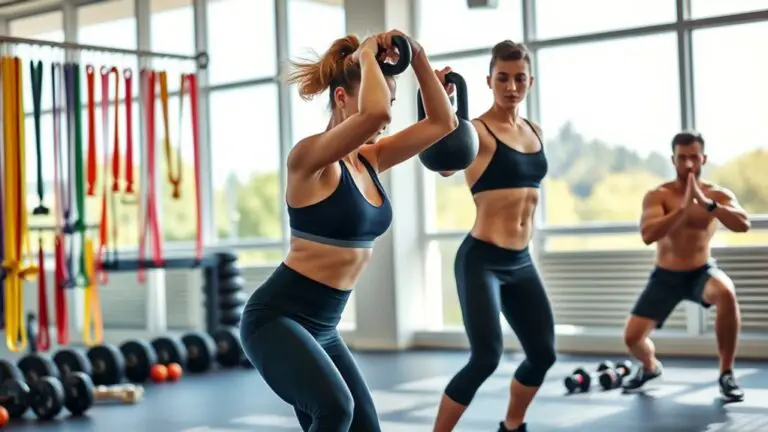The Best Gym Exercises for Toning Inner Thighs
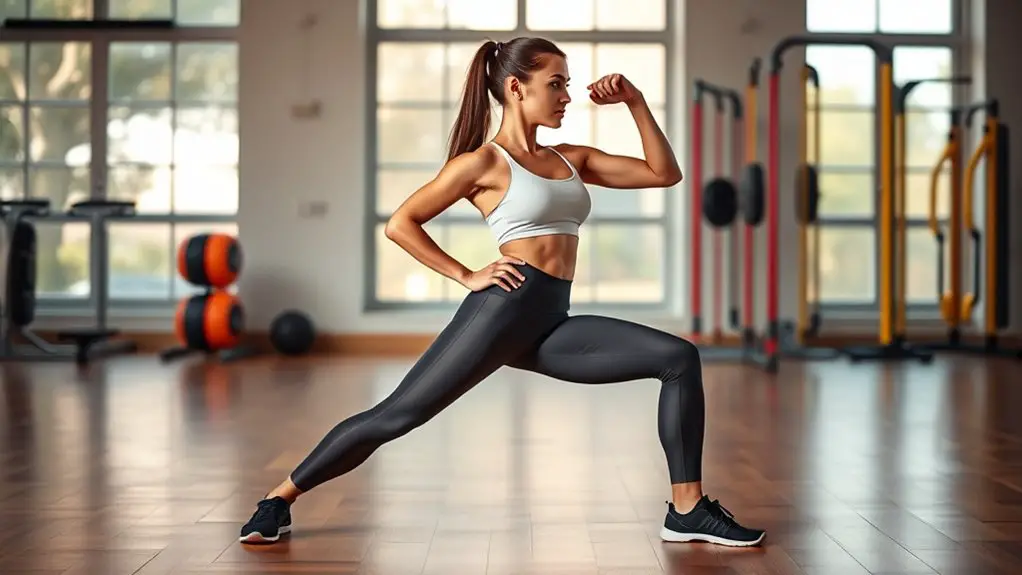
To tone your inner thighs effectively, try incorporating sumo squats, inner thigh cable kickbacks, and dumbbell lunges into your routine. The leg press machine and stability ball wall sits also target those muscles while improving core stability. Don’t forget resistance band side leg raises and plank with leg lifts for a thorough approach. Each exercise focuses on form and controlled movements, ensuring great results. Discover additional techniques to maximize your workouts and achieve your fitness goals.
Sumo Squats

Sumo Squats
Sumo squats are one of the most effective exercises for targeting your inner thighs. By adopting a wider stance, you engage those muscles while also working your glutes and quads. One of the key sumo squat benefits is improved flexibility and strength in your lower body, which can enhance performance in other activities.
To guarantee safety, always keep your core engaged and avoid letting your knees go past your toes. Start with bodyweight and gradually add weights as you become more comfortable.
There are several sumo squat variations you can try, like holding a kettlebell or performing a sumo squat jump to increase intensity. These variations can keep your workout fresh and challenging while effectively targeting those inner thigh muscles. Remember, form is essential, so take your time to master the basics before advancing. Additionally, incorporating exercises like jumping rope can further enhance your overall strength and coordination during workouts.
Inner Thigh Cable Kickbacks
Inner thigh cable kickbacks are a fantastic way to target those hard-to-reach muscles. You’ll need a cable machine for this exercise, but mastering the proper form is key to getting the most out of it. Plus, there are variations you can try to increase the intensity and keep your workouts challenging.
Equipment Needed
To effectively perform inner thigh cable kickbacks, you’ll need a few essential pieces of equipment to maximize your workout. Using the right gym equipment and fitness accessories can enhance your safety and effectiveness. Here’s a quick overview of what you’ll need:
| Equipment | Purpose | Safety Tips |
|---|---|---|
| Cable Machine | Provides resistance for kicks | Guarantee proper weight setting |
| Ankle Strap | Secures cable to your ankle | Check for tightness |
| Exercise Mat | Adds comfort and stability | Use a non-slip mat |
| Weight Belt | Supports lower back when needed | Adjust for snug fit |
| Resistance Bands | Alternative resistance option | Guarantee no wear or tears |
With the right equipment, you’ll be ready to tone those inner thighs safely and effectively!
Proper Form Techniques
Once you have your equipment set up, it’s important to focus on proper form techniques for inner thigh cable kickbacks. Start by adjusting the cable to a low position and attaching the ankle strap. Stand tall, maintaining good posture alignment, with your feet hip-width apart. Engage your core for stability and shift your weight onto one leg, ensuring you’re balanced. As you kick back with the other leg, keep it straight and avoid swinging. Instead, control the movement, focusing on the inner thigh as you return to the starting position. Don’t forget to breathe and maintain a steady pace. Practicing these techniques will enhance your balance training and help you effectively target your inner thighs while minimizing the risk of injury.
Variations for Increased Intensity
While standard inner thigh cable kickbacks effectively target your muscles, incorporating variations can elevate your workout intensity and results. To safely enhance your routine, try exercise modifications like adding a pause at the top of each kickback. This increases time under tension, providing an intensity booster. You can also use a lighter weight or resistance band to perform high-rep sets, focusing on form and control. Another option is to combine kickbacks with a squat, engaging multiple muscle groups while intensifying the burn in your inner thighs. Remember to maintain proper alignment and avoid overextending your back. By integrating these variations, you’ll not only challenge your muscles but also keep your workouts fresh and effective.
Dumbbell Lunges
Dumbbell lunges are an excellent way to target your inner thighs while also engaging your glutes and quads. They’re versatile and can be adjusted using various dumbbell variations, allowing you to find a weight that suits your fitness level. To perform a lunge safely, step forward with one leg while keeping your back straight and your core engaged. Lower your body until your front thigh is parallel to the ground, ensuring your knee doesn’t extend past your toes.
One of the key lunge benefits is that they improve balance and coordination, which are essential for overall fitness. Start with a lighter weight to master the form, then gradually increase the dumbbell weight for added resistance. Remember, consistency is key, so incorporate lunges into your routine a few times a week for the best results. Always listen to your body, and don’t hesitate to consult a trainer if you’re unsure about your technique.
Leg Press Machine
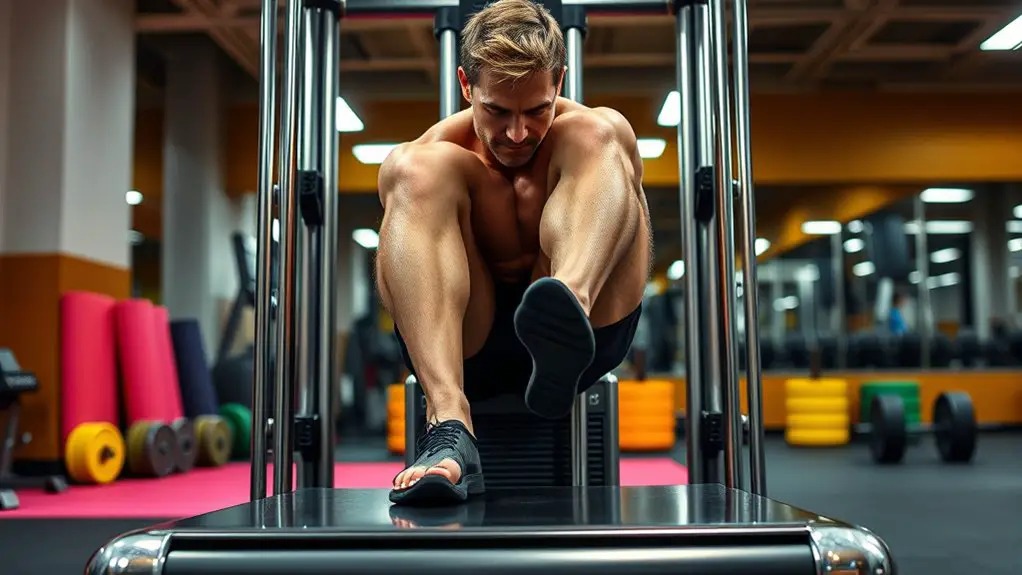
After mastering dumbbell lunges, the leg press machine can be a powerful addition to your inner thigh workout. It allows for targeted muscle engagement, helping to tone and strengthen your inner thighs safely. Here’s how to use it effectively:
- Adjust the Seat: Confirm that the seat is positioned so your knees can form a 90-degree angle when your feet are on the platform.
- Foot Placement: Place your feet shoulder-width apart on the platform, with toes slightly pointed outwards. This position emphasizes the inner thigh muscles.
- Controlled Movement: Push the platform away slowly, focusing on your inner thighs as you extend your legs. Avoid locking your knees at the top.
Always start with lighter weights to gauge your strength, and increase gradually to prevent injury. With consistent practice, you’ll notice significant improvements in your inner thigh strength and tone.
Stability Ball Wall Sits
A stability ball wall sit is an excellent way to engage your inner thighs while also improving core stability. This exercise combines the strength-building benefits of a traditional wall sit with the added challenge of a stability ball, which helps maintain proper posture and alignment. To perform this move safely, place the stability ball between your lower back and the wall, ensuring your feet are shoulder-width apart.
Lower your body into a seated position, keeping your knees aligned with your toes. Hold the position for 20-60 seconds, focusing on your breathing. You can explore wall sit variations, like adding arm movements or adjusting the ball’s height, to keep things interesting while maximizing stability ball benefits. Remember to listen to your body; if you feel any discomfort, adjust your position or take a break. Incorporating stability ball wall sits into your routine can greatly tone your inner thighs while enhancing overall strength.
Resistance Band Side Leg Raises
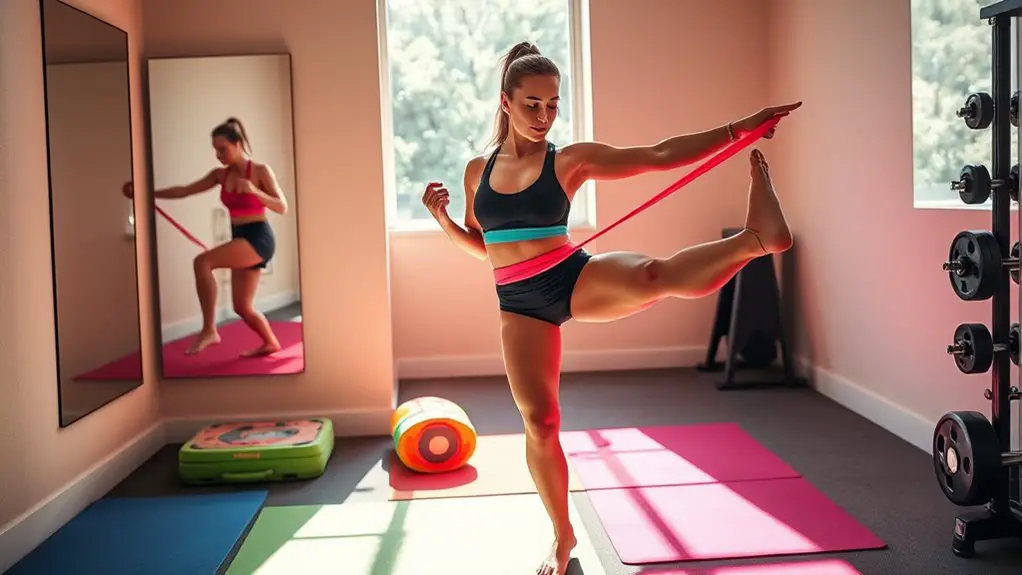
Building on the stability ball wall sits, resistance band side leg raises are another fantastic exercise for targeting your inner thighs. This leg exercise not only tones but also stabilizes your muscles, helping to prevent injuries. Here’s how to do it safely:
- Choose the Right Band Resistance: Start with a band that offers enough resistance to challenge you without compromising form.
- Position Yourself Correctly: Stand tall and loop the resistance band around your ankles. Keep your core engaged for stability.
- Execute the Movement: Slowly lift one leg to the side, keeping it straight. Lower it back down without touching the ground to maintain tension in the band.
Plank With Leg Lifts
Plank with leg lifts is an excellent way to engage your core while specifically targeting your inner thighs. To perform this exercise safely, start in a plank position with your body in a straight line from head to heels. Verify your hands are directly under your shoulders, and your core is tight for maximum core stability.
Once you’re stable, lift one leg slowly toward the ceiling while keeping your hips square and your body steady. Focus on using your inner thigh muscles for the lift, and avoid letting your lower back sag. Hold the position briefly before lowering your leg back down.
Alternate legs, repeating the movement for several reps. This exercise not only promotes leg strength but also enhances overall core stability, helping you maintain good form and prevent injuries. Always listen to your body and modify as needed to verify a safe and effective workout.
Frequently Asked Questions
How Often Should I Do These Exercises for Best Results?
You might be wondering how often you should really commit to these exercises for ideal results. Frequency recommendations suggest aiming for two to three times a week. But remember, workout consistency is key. It’s important to listen to your body—don’t push yourself too hard. Allow for rest days to prevent injuries and guarantee safety, so your muscles can recover and grow stronger. With patience and dedication, you’ll see the progress you’re aiming for.
Can I Tone My Inner Thighs Without Equipment?
Absolutely, you can tone your inner thighs without equipment! Bodyweight exercises like squats, lunges, and side leg raises can be really effective. Incorporating effective stretches, such as the butterfly stretch or the standing quad stretch, can also help enhance flexibility and strength in that area. Just remember to focus on form and listen to your body to avoid injury. With consistency, you’ll see improvements in your inner thigh tone!
What Is the Ideal Number of Sets and Reps?
Imagine you’re a sculptor, chiseling away at a block of marble. The ideal repetitions are like the careful strokes of your chisel—aim for 3 to 4 sets of 10 to 15 reps. Experiment with exercise variations to keep things fresh and safe. Listen to your body; if it feels too easy or hard, adjust accordingly. Just like art, finding your balance takes time, but the masterpiece will be worth it!
Are There Any Dietary Tips to Complement My Workout?
To complement your workout, focusing on meal timing and protein sources can make a big difference. Try to eat a balanced meal with protein about 30 minutes after exercising, as this helps with recovery and muscle growth. Incorporate lean protein sources like chicken, fish, or plant-based options. Also, consider having smaller, nutrient-dense snacks throughout the day to keep your energy levels stable and support your fitness goals safely.
How Long Will It Take to See Results?
How long will it take to see results? Well, it really depends on several factors, including your consistency and workout intensity. Typically, you might start noticing changes in about four to six weeks, but everyone’s results timeline varies. To stay motivated, consider progress tracking through measurements or photos. Just remember, safe and sustainable improvements are key, so focus on gradual changes rather than quick fixes for the best outcomes.


